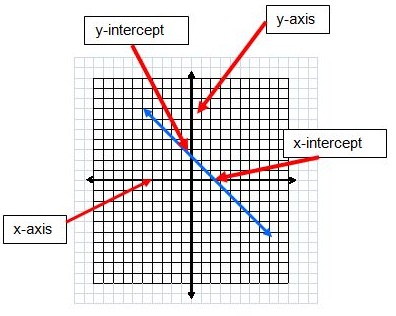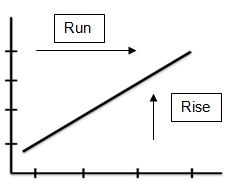Linear Equations Content Module
BACK TO Content Modules
Contents |
Plot the course
The rationale
Everyday people use linear equations to problems solve in their life. For example, ever wondered how many miles you could drive on a certain number of gallons of gas when planning a road trip? In addition to everyday activities, there are many jobs that require a firm understanding of linear equations such as jobs in construction.
Module Goal
The goal of this module is to provide detailed instruction on the more difficult concepts within linear equations to teachers of students with disabilities at the middle and high school level. This module promotes a mathematical understanding of these concepts so that a teacher can begin to plan how to teach the concepts to students. Additionally, this module will provide instructors with potential adaptations and modifications to consider when designing materials and instruction for students with severe disabilities.
Module Objectives
After viewing the content module, teachers will:
- Identify the type of slope (positive, negative, zero, or undefined) when provided a graph of a linear equation.
- Find the slope of a line when given the coordinates for two points on that line.
- Determine the equation for a line when given the slope of a line and one point on the line.
Time for take off
Understanding the vocabulary used within linear equations is important for both teachers and students in planning and implementing math lessons. As a teacher, knowing and using the mathematical terms not only ensures your instruction stays true to the math content, but will also help with collaborating with other math teachers or content experts. When choosing which vocabulary to teach, it is most important that the teacher selects the most salient, important, or most frequently used vocabulary for each lesson. Below you will find a list of vocabulary included within this module. It may or may not be necessary to provide instruction for all terms as students may have learned them previously. Linear equations are mostly covered in middle school so vocabulary for this content module has been combined. If you are a high school teacher and are not confident your students know some of these vocabulary terms, you may want to review and teach some unknown terms in the focus and review part of your lesson plan. While providing vocabulary instruction, you may consider including pictures or objects to make the instruction more concrete for students with disabilities (See Ideas to support vocabulary learning below).
Vocabulary
- Variable - a letter that represents a value
- Terms - expressions that are separated by a plus or minus sign (e.g., 2t-3b=)
- Like terms - terms that have the same variable (e.g., 2t and 3t are like terms)
- Linear equation - an equation whose solution falls on a line when graphed
- Rate of change - a ratio that compares change in a dependent variable in relation to a change in the independent variable
- Slope - the slope of a line is the ratio of rise over run for any two points on that line
- Rise - difference between two y-values on a line
- Run - difference between two x-values on a line
- X-intercept - the point where a line crosses the x axis
- Y-intercept - the point where a line crosses the y-axis
Ideas to support vocabulary learning
- Include pictorial representations

Floating on Air
Before you can begin teaching linear equations, you need a deep understanding of these mathematical concepts. Some of these concepts may be familiar to you. Below is a list of skills that should be covered at each grade level. For concepts that you need more information about, please view the accompanying PowerPoint presentations that will walk you through an example as well as make some suggestions for instruction.
- NOTE: Icons designate Core Content Connectors addressed within a developed SASSI*
Middle and High School
In middle school skills include:
- 6.PRF.2a4 Analyze the relationship between the dependent and independent variables using graphs and tables, and relate these to the equation
-
 6.PRF.1d1 Solve real-world single step linear equations
6.PRF.1d1 Solve real-world single step linear equations
(Insert solving linear equations PowerPoint presentation here)
- 6.PRF.2b2 Using provided table with numerical patterns, form ordered pairs
- 7-8.NO.3c5 Explain each step to solve a problem (e.g., explain how to solve-multi-step equation)
-
 7.PRF.1g2 Use variables to represent quantities in a real-world or mathematical problem, and construct simple equations and inequalities to solve problems by reasoning about the quantities
7.PRF.1g2 Use variables to represent quantities in a real-world or mathematical problem, and construct simple equations and inequalities to solve problems by reasoning about the quantities
- 8.PRF.2c1 Given two graphs, describe the function as linear and not linear
(Insert interpreting graphs PowerPoint presentation here)
- 8.PRF.1f2 Describe or select the relationship between the two quantities given a line graph of a situation
- 8.PRF.1g3 Solve linear equations with 1 variable
- 8.PRF.2e2 Identify the rate of change (slope) and initial value (y-intercept) from graphs
In high school skills include:
- H.PRF.1a1 Interpret the rate of change using graphical representations
- H.PRF.2a1 Translate an algebraic expression into a word problem
(Insert linear equations and word problems PowerPoint here)
-
 H.PRF.1b1 In a linear situation using graphs or numbers, predicts the change in rate based on a given change in one variable
H.PRF.1b1 In a linear situation using graphs or numbers, predicts the change in rate based on a given change in one variable
- H.PRF.2b1 Translate a real-world problem into a one variable linear equation
- H.PRF.1c1 Select the appropriate graphical representation of linear model based on real-world events
- H.PRF.2b2 Solve equations with one or two variables using equations or graphs
Great! Now that you have viewed the PowerPoint presentations most useful to you, the next section will provide some ideas to consider when planning for universal design for learning.
Slope-Intercept and Point-Slope Form : An Overview of Linear Equations
Sharing the Sky
UNIVERSAL DESIGN FOR LEARNING
| Visual Impairment or Deaf/Blind | Physical Impairment:
Little/ No Hand Use |
Lacks Basic Numeracy Concepts | Motivational/ Attention Issues | |
| Representation | Use a graphing calculator so students can just plug in the equation; raise the lines of the graphed linear equation or of the grid when graphing; add corresponding textures (e.g., Velcro) to equations and calculators; have students scan raised lines with hands to discriminate between the different kinds of slope (i.e., negative, positive, zero, and undefined) | Student scans an array of possible options and uses a switch to select the appropriate slope or ordered pair; graph linear equations on the computer that can be manipulated with switch | Have student use graphing calculator; color code equations and corresponding parts of calculator to support students correctly entering equations; use conversion tables with pictures or objects to points on a line | Create personally-relevant word problems; use graphing calculators or computer software to find slopes or graph equations; |
| Expression | Student states answer or scans raised numbers to select correct answer; use voice output devices for student to select the correct answer | Use a switch to indicate correct answers; use an eye gaze board to select answer; use a blink response to complete a table to find points on a line given the equation; phrase questions so that they require a "yes/no" response, these can easily be answered using an eye gaze, head turn, two switches, etc. | Student selects numbers versus writing them; selection of correct answer is done after a model; student points to each part of the equation when asked to touch the slope or the y-intercept | Have students graph linear equations using high interest manipulatives (e.g., computer software, on an iPad, using their favorite color) |
| Engagement | Teach students to use their hands to scan the raised lines or grid of a graph; use graphing calculator and add texture to support entering linear equations | Use a computer with AT where the student can click to answer; use manipulatives that are large and easily manipulated; pair student with another student without a physical impairment and have them work together to solve linear equations or complete tables | Student uses graphing calculator, limit ordered pairs to numerals less than 10, use bright colors to represent the ordered pairs that are the coordinates of a point on the line | Find dilations of local buildings and use those dilations to make a scale model of the neighborhood; create personally-relevant word problems about highly preferable activities (e.g., going to the mall; food) |
Prepare for landing
Below you will find ideas for linking linear equations to real-world applications, the college and career readiness skills addressed by teaching these concepts, module assessments for teachers, sample general education lesson plans incorporating universal design for learning framework, blog for teachers to share their ideas, and a place to upload and share lesson plans from teachers who completed this module. One way to help assist in a special educator's development within this curricular area is through collaboration with other teachers in your building. Some activities with real world connection include:
- Locating points on a map that has a grid like an atlas
- Determining how many miles you can travel on a certain number of gallons of gas (e.g., If you get 32 miles per gallon…. Then, Y = 32x where x is the number of gallons of gasoline and y is miles traveled)
- Determining the daily cost of a gym membership where you have to pay a joining fee on top of the monthly fee (e.g, $10 joining fee. $15 a month. Y = 15x+10 where x is number of months and y is total cost)
In addition to the real-world applications of these concepts, skills taught within this content module also promote the following college and career readiness skills. Communicative competence: Students will increase their vocabulary to include concepts related to "linear". In addition, they will be learning concepts such as: "horizontal", "vertical", and "slope".
Fluency in reading, writing, and math Students will have an opportunity to increase their numeracy and sight word fluency while participating in problem solving related to "linear equations" such as number recognition, counting, one-to-one correspondence, and reading concepts that include the use and understanding of descriptors related to slope.
Age appropriate social skills Students will engage in peer groups to solve problems related to "linear equations" that will provide practice on increasing reciprocal communication and age appropriate social interactions. For example, students might work together with their peers to enter an equation into a graphing calculator
Independent work behaviors By solving real life problems related to "linear equations" students will improve work behaviors that could lead to employment such as marketing or any job that has to analyze sales rates, stock clerks, order fillers, and other construction based professions. When providing opportunities for real life problems leave some materials out and prompt/teach the students to determine who they should ask and what they should ask for to be able to solve the problem.
Skills in accessing support systems At times, students will need to ask for assistance to complete activities related to "linear equations" which will give them practice in accessing supports. Students will gain practice asking for tools such as graphing calculators, or other manipulatives. They can ask a peer to complete the physical movements of the tasks they are not about to do themselves. Be sure to teach students to ask versus having items or supports automatically given to them. In addition to collaborating with other educational professionals in your building, the following list of resources may also help provide special educators with ideas for activities or support a more thorough understanding of the mathematical concepts presented in this content module.
Additional Resources
- www.xpmath.com not only does this website provide additional teacher support for teaching linear equations, this website also provides a link to why these skills are important to different professions and jobs.
- www.cumbavac.org provides a variety of activities, work sheets, and web quests to use in your classroom
- www.mathforum.com website specifically for teachers which provides a variety of ideas and activities to use in your classroom
- www.teachertube.com- Youtube for teachers! Simply search for your content area and this websites provides a variety of videos including videos of math experts working through math problems step by step (free registration required)
- http://exchange.smarttech.com this SMART board exchange has developed lessons by classroom teachers differentiated by grade level. You can also search by skill and/or state standards.
- www.ksde.org this website provides a webinar about how to adapt materials for students who have visual impairments
Module Assessments
Below are links to assessments for the purpose of self-checking your understanding of the content in this module. After answering the assessment questions, you may want to review the key to check your work.





